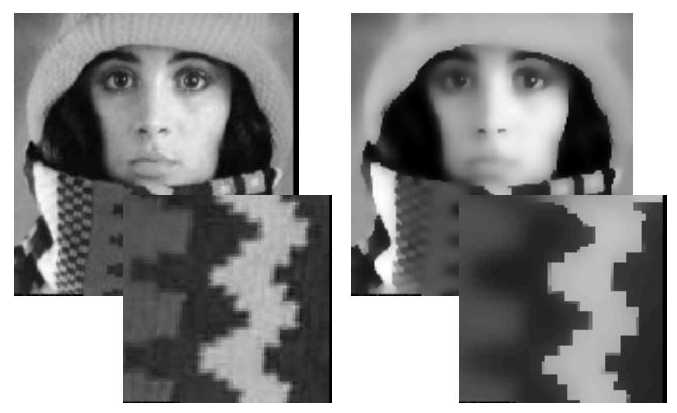Nonlinear Diffusion
in
Computer Vision
Contents

Image smoothing not only pleases the eye or facilitates automated image analysis. When incorporating geometrical expertise in deciding what structures in an image to smooth and what structures to preserve (or even stress) it can even be regarded to be a segmentation technique.
Nonlinear diffusion is an image smoothing technique that is based on the physical notion of diffusion. The smoothing can be locally controlled with the diffusion tensor in such a way that in the neighborhood of edges smoothing is less pronounced then in other areas.
Nonlinear diffusion generalizes the well known linear diffusion. The linear diffusion (partial differential) equation has been introduced by Koenderink as the causality requirement for linear scale-spaces.
Nonlinear diffusion in the computer vision context was introduced by Perona and Malik. Their inhomogenuous diffusion technique controls the smoothing locally based on the (first order) edge strength.

Whereas Perona and Malik types of nonlinear diffusion are isotropic (Perona and Malik erronuously called 'their' diffusion anisotropic), more advanced diffusion schemes are capable of selecting prefered diffusion directions. This allowed Weickert to define coherence enhancing diffusion where 'smoothing is directed to be along the image isophotes'. A nice example is the processing of fingerprint images.
Diffusion equations are partial differential equations and we need numerical (approximation) techniques to solve them (i.e. smooth the image). In this course we only discuss the simplest of all possible schemes: explicit forward Euler solution schemes.
Lecture 1:
- Gaussian scale-space
- Causality in scale-space
- The physics of diffusion
- Numerical solutions I
Lecture 2:
- Inhomogenous diffusion
- Perona and Malik
- Inverse diffusion
- Numerical solutions II
Lecture 3:
- Anisotropic diffusion
- Edge enhancing diffusion
- Coherence enhancing diffusion
- Numerical solutions III
this page is maintained by
Rein van
den Boomgaard
rein@science.uva.nl